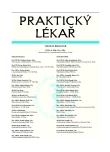Importance of blood count for diagnosis and prognosis in patients with myelodysplastic syndrome
Authors:
J. Vondráková 1; J. Zapletalová 2; J. Indráková 1; K. Indrák 1
Authors‘ workplace:
Hemato-onkologická klinika Fakultní nemocnice a Lékařská fakulta Univerzity Palackého, Olomouc
Přednosta: prof. MUDr. Karel Indrák, DrSc.
1; Ústav lékařské biofyziky, Lékařská fakulta Univerzity Palackého, Olomouc
Přednostka: doc. RNDr. Hana Kolářová, CSc.
2
Published in:
Prakt. Lék. 2009; 89(6): 324-327
Category:
Diagnostis
Overview
Myelodysplastic syndrome (MDS) is a clonal haematopoietic disorder characterised by dysplastic bone marrow. It manifests as mono-, bi - or pancytopenia in peripheral blood and eventually can progress to leukaemia. The first important laboratory assessment on suspicion of MDS, to enable the differential diagnosis of this syndrome is full blood count (CBC), based on which, other specialised tests are indicated to confirm diagnosis of MDS. The careful evaluation of all parameters of blood count can contribute to rapid estimation of MDS prognosis.
The aim of the retrospective analysis of 100 MDS patients examined within the period from 2000–2008 at the Haemato-oncology Department of the University Hospital, Olomouc was to evaluate the initial parameters of blood count for the risk of leukaemia development and overall survival (OS). Statistically significant unfavourable prognostic factors for OS showed thrombopenia, neutropenia, presence of blast cells in peripheral blood, peripheral blast cells ≥ 5 % and low platelet mass. The favourable factors were macrocytosis and lymphocytopenia. The level of haemoglobin (Hb), MPV and RDW were not shown as statistically significant for the prognosis. The risk factors of leukaemia development were thrombopenia, low or normal platelet mass, normal or low MCV, presence of blasts cells in peripheral blood, neutropenia, and lymphocytosis. Another parameters of CBC (Hb, RDW, MPV) were not statistically significant for leukaemia development in our group. This analysis confirms the importance of CBC not only as a basic diagnostic laboratory test but also as a prognostic indicator for MDS patients.
Key words:
myelodysplastic syndrome, blood count (CBC), prognostic factors, risk of leukaemia development.
Sources
1. Adam, Z., Penka, M., Doubek, M. Myelodysplastický syndrom a myelodysplastické/ myeloproliferativní choroby. In Adam, Z. a kol.: Diagnostické a léčebné postupy u maligních chorob. Praha: Grada Publishing, 2002, s. 341-350.
2. Bennett, M. J., Catovsky, D., Daniel, T. M. et al. Proposals for the classification of the myelodysplastic syndromes. Br. J. Haematol., 1982, 51, p. 189-199.
3. Bowles, M. K., Warner, A. B., Baglin, P. T. Platelet mass has prognostic value in patients with myelodysplastic syndromes. Br. J. Haematol., 2006, 135, p. 198-200.
4. Čermák, J., Vítek A., Michalová, K. a kol. Myelodysplastický syndrom v novém tisíciletí. Jak klasifikovat a jak léčit nemocné? Vnitř. Lék., 2005, 51, 1, s. 20-30.
5. Čermák, J. Myelodysplastický syndrom. Doporučené postupy pro praktické lékaře. ČLS JEP, projekt MZ ČR, reg. č. o/017/301, dostupný z WWW: <http://www.cls.cz/dp>
6. Hochová, I., Neuwirtová, R., Vodičková, E. a kol. Myelodysplastický syndrom. Diagnostický atlas. Praha: Jessenius, Maxdorf, 2006, 323 s. ISBN 80-7345-088-7.
7. Indrák, K. a kol. Hematologie. Postgraduální klinický projekt. Vnitřní lékařství VII. Praha: Triton, 2006, 278 s. ISBN 80-7254-868-9.
8. Kačírková, P., Campr, V. Hematoonkologický atlas krve a kostní dřeně. Praha: Grada Publishing 2007, 285 s. ISBN 978-80-247-1853-8.
9. Matsuda, A., Misumi, M., Yoshida, K. et al. Is macrocytosis a favourable prognostic factor in myelodysplastic syndrome patients without increased blasts? Br. J. Haematol., 2003, 121, p. 815-816.
10. Neuwirtová, R. Myelodysplastický syndrom: onkohematologické onemocnění vyššího věku. Čes. Ger. Rev., 2005, 3, 2, s. 21-28.
11. Neuwirtová, R., Mociková, K., Jelínek, J. a kol. Smíšené myelodysplastické a myeloproliferativní syndromy. Čas. Lék. čes., 1997, 136, s. 724-729.
12. Palmer, R. S., Tefferi, A., Hanson, A. C., Steensma, P. D. Platelet count is an IPSS-independent risk factor predicting survival in refracotry anaemia with ringed sideroblasts. Br. J. Haematol., 2008, 140, p. 722-724.
13. Vardiman, W. J., Harris, L. N., Brunning, D. R. The World Health Organization (WHO) classification of the myeloid neoplasms. Blood, 2002, 100, 7, p. 2292-2302.
Labels
General practitioner for children and adolescents General practitioner for adultsArticle was published in
General Practitioner

2009 Issue 6
- Metamizole vs. Tramadol in Postoperative Analgesia
- Metamizole at a Glance and in Practice – Effective Non-Opioid Analgesic for All Ages
- Memantine in Dementia Therapy – Current Findings and Possible Future Applications
- Advances in the Treatment of Myasthenia Gravis on the Horizon
- Hope Awakens with Early Diagnosis of Parkinson's Disease Based on Skin Odor
Most read in this issue
- Health problems related to drug abuse, possibility of prevention in primary care
- Errors in the treatment of delirium tremens
- Syndrome of combined pulmonary fibrosis and emphysema – CPFE syndrome
- Painful foot
